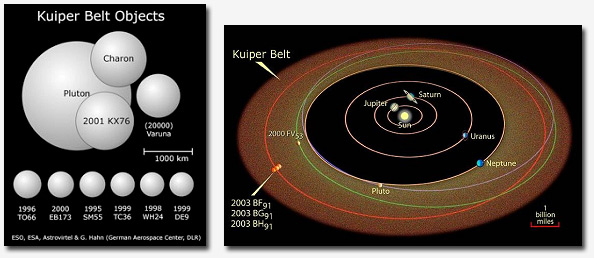Kuiper belt is the most recently observed section of the Solar System.
Kuiper belt extends from Neptune's orbit to three billion kilometers beyond it.
Contains lumps of icy material with organic compounds; makes them like comets. Called "Kuiper belt objects" (KBO's) or minor planets.
Kuiper belt may have formed when the gravity of the young Jupiter sent the Kuiper belt objects out to where they are now.
Scientists consider Pluto to be one of the largest Kuiper belt objects. It is 2390 km across.
After Pluto, next largest known Kuiper belt objects are Orcus, which is about 1600 km (1,000 miles) across, 2003 EL61 at 70% the size of Pluto and 2005 FY9 at 50% to 70% of Pluto's size.
Recently, scientists found an object, 2003 UB313, that is bigger than Pluto. The scientists don't know its exact size, but the estimate it is about 20% larger than Pluto. At the time it was discovered, it was almost 100 times further away from the Sun than Earth is. It can come about as close to the Sun as Pluto is. Its orbit is tilted almost 45 degress compared to Earth's orbit. Pluto's orbit is tilted by only 17 degrees. Some people are calling it the tenth planet. Others don't think that 2003 UB313 is a planet and don't think that Pluto should be considered one either.
Other large Kuiper belt objects about or over 1000 km across are Pluto's moon Charon, Quaoar, Varuna, Ixion, 1996 TL66, 2002 TX300, 2002 TC302, 2002 UX25 and 2002 AW197. Ceres, the largest asteroid, is about 950 km across.
By 2004, over 800 Kuiper belt objects had been found. Scientists think that there are many more yet to be discovered, and some might be as big as Earth (though much colder).
After the first object in the belt was spotted from the Mauna Kea Observatory in Hawaii, the belt was named after the astronomer Gerard Kuiper, who, in 1951, wrote that he thought it had existed very long ago.
Astronmomers including Frederick Leonard, Kenneth Edgeworth, and Julio Fernandez thought that the belt still existed; and some astronomers call it the Edgeworth-Kuiper belt.
When an object is discovered in space, it is given a temporary name called a "provisional designation". This temporary name begins with the year the object was discovered, followed by some letters and numbers that tell in what month and in what order it was discovered. Later on, important objects are given other names, often from mythology.
Orcus, Charon, and Varuna were named after mythological gods of the underworld. Ixion was named after a mythological person in the underworld. Quaoar was named after a creation god of the Native American Tongva people.

